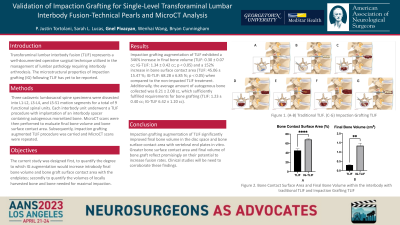Validation of Impaction Grafting for Single Level TLIF, Technical Pearls and Micro CT Analysis
Friday, April 21, 2023


Gnel Pivazyan, MD (he/him/his)
Resident Physician
MedStar Georgetown University Hospital
Washington, DC, US
ePoster Presenter(s)
Introduction: Transforaminal lumbar interbody fusion (TLIF) represents a well-documented operative surgical technique utilized in the management of lumbar pathology requiring interbody arthrodesis. The microstructural properties of impaction grafting (IG) following TLIF has yet to be reported.
The current study was designed first, to quantify the degree to which IG augmentation would increase intrabody final bone volume and bone graft surface contact area with the endplates; secondly to quantify the volumes of locally harvested bone and bone needed for maximal impaction.
Methods: Three cadaveric lumbosacral spine specimens were dissected into L1-L2, L3-L4, and L5-S1 motion segments for a total of 9 functional spinal units. Each interbody unit underwent a TLIF procedure with implantation of an interbody spacer containing autogenous morselized bone. MicroCT scans were then performed to evaluate final bone volume and bone surface contact area. Subsequently, impaction grafting augmented TLIF procedure was carried and MicroCT scans were repeated.
Results: Impaction grafting augmentation of TLIF exhibited a 346% increase in final bone volume (TLIF: 0.30 ± 0.07 cc; IG-TLIF: 1.34 ± 0.42 cc; p < 0.05) and a 152% increase in bone surface contact area (TLIF: 45.06 ± 15.47 %; IG-TLIF: 68.28 ± 6.85 %; p < 0.05) when compared to the non-impacted TLIF treatment. Additionally, the average amount of autogenous bone collected was 8.21 ± 2.08 cc, which sufficiently fulfilled requirements for bone grafting (TLIF: 1.23 ± 0.40 cc; IG-TLIF 6.42 ± 1.20 cc).
Conclusion : Impaction grafting augmentation of TLIF significantly improved final bone volume in the disc space and bone surface contact area with vertebral end plates in vitro. Greater bone surface contact area and final volume of bone graft reflect promisingly on their potential to increase fusion rates. Clinical studies will be need to corroborate these findings.
The current study was designed first, to quantify the degree to which IG augmentation would increase intrabody final bone volume and bone graft surface contact area with the endplates; secondly to quantify the volumes of locally harvested bone and bone needed for maximal impaction.
Methods: Three cadaveric lumbosacral spine specimens were dissected into L1-L2, L3-L4, and L5-S1 motion segments for a total of 9 functional spinal units. Each interbody unit underwent a TLIF procedure with implantation of an interbody spacer containing autogenous morselized bone. MicroCT scans were then performed to evaluate final bone volume and bone surface contact area. Subsequently, impaction grafting augmented TLIF procedure was carried and MicroCT scans were repeated.
Results: Impaction grafting augmentation of TLIF exhibited a 346% increase in final bone volume (TLIF: 0.30 ± 0.07 cc; IG-TLIF: 1.34 ± 0.42 cc; p < 0.05) and a 152% increase in bone surface contact area (TLIF: 45.06 ± 15.47 %; IG-TLIF: 68.28 ± 6.85 %; p < 0.05) when compared to the non-impacted TLIF treatment. Additionally, the average amount of autogenous bone collected was 8.21 ± 2.08 cc, which sufficiently fulfilled requirements for bone grafting (TLIF: 1.23 ± 0.40 cc; IG-TLIF 6.42 ± 1.20 cc).
Conclusion : Impaction grafting augmentation of TLIF significantly improved final bone volume in the disc space and bone surface contact area with vertebral end plates in vitro. Greater bone surface contact area and final volume of bone graft reflect promisingly on their potential to increase fusion rates. Clinical studies will be need to corroborate these findings.
